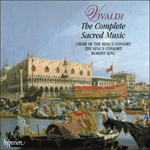
Welcome to Hyperion Records, an independent British classical label devoted to presenting high-quality recordings of music of all styles and from all periods from the twelfth century to the twenty-first.
Hyperion offers both CDs, and downloads in a number of formats. The site is also available in several languages.
Please use the dropdown buttons to set your preferred options, or use the checkbox to accept the defaults.

The hymn has six stanzas, of which Vivaldi sets only the first, third and sixth. In typical fashion, each stanza has the same music and is preceded by an identical instrumental ritornello. This ritornello illustrates Vivaldi’s fondness for grouping phrases in threes rather than twos; its twelve bars subdivide as 4 + 4 + 4.
Everything about this setting is simple, but Vivaldi rescues it from banality by his use of lightly syncopated (‘sawing’) rhythms. By such discreet means, he is able to turn artlessness into something genuinely artistic.
from notes by Michael Talbot © 2002
Parmi les six strophes que comporte cette hymne, Vivaldi met en musique les première, troisième et sixième. De manière caractéristique, toutes les strophes utilisent la même musique et sont précédées d’une ritournelle instrumentale identique. Celle-ci illustre la propension de Vivaldi à grouper les phrases par trois plutôt que par deux ; ses douze mesures se subdivisent en 4 + 4 + 4.
Cette pièce est d’une grande simplicité, mais échappe à la banalité grâce à l’utilisation que fait Vivaldi de rythmes légèrement syncopés. C’est par le biais de procédés aussi discrets qu’il parvient à donner à une pièce d’apparence toute simple une dimension authentiquement artistique.
extrait des notes rédigées par Michael Talbot © 2002
Français: Josée Bégaud
Das Lied hat sechs Strophen, wovon Vivaldi nur die erste, dritte und sechste vertont. Nach traditioneller Weise hat jede Strophe dieselbe Musik und es ist jeweils ein identisches, instrumentales Ritornello vorangestellt. Dieses Ritornello illustriert Vivaldis Vorliebe dafür, musikalische Phrasen lieber in Dreiergruppen als in Zweiergruppen anzuordnen: die zwölf Takte unterteilen sich in 4+4+4.
Alles an dieser Vertonung ist schlicht, jedoch bewahrt Vivaldi sie vor der Banalität, indem er leicht synkopierte („sägende“) Rhythmen verwendet. Mit derart diskreten Mitteln gelingt es ihm, Schmucklosigkeit in wahre Kunst zu verwandeln.
aus dem Begleittext von Michael Talbot © 2002
Deutsch: Viola Scheffel
 Vivaldi: The Complete Sacred Music Vivaldi: The Complete Sacred Music‘For King's sterling service to the Vivaldian cause, one of his most important recording and satisfying projects to date, I am thankful’ (Gramophone) ‘If you're waiting for the perfect collection of Vivaldi's sacred music, this is it. It was a happy day when this beautiful boxed set arrived in my m ...» More |

